| |
Brief Report: HIV Prevalence and the Prevalence of Unsuppressed HIV in New York City, 2010-2014
|
| |
| |
Download the PDF here
From Jules - Ending AIDS ??? Seems difficult
HIV prevalence in NYC remained unchanged at 1.22% (95% CI: 1.21% to 1.24%) in 2010 and 1.22% (95% CI: 1.20% to 1.24%) in 2014. The prevalence of unsuppressed HIV steadily decreased from 0.49% (95% CI: 0.48% to 0.51%) in 2010 to 0.34% (95% CI: 0.32% to 0.36%) in 2014 (Fig. 1).
BUT.....if you look at Table 1 you see why overall prevalence went down - because the age groups with the biggest populations 35-44 & 44-54 went down but for every other age age group prevalence increased.
AND if you look in Table 1 below at age groups in women at the age groups regarding HIV prevalence although it decreased over all in 2 age groups prevalence increased - 55 to 64 and over 65.
eFigure 3, http://links.lww.com/QAI/A978 shows a different pattern by age from the overall one in that male HIV prevalence increased among persons aged 25-34, 55-64, and 65+ year-olds, was stable among 18-24-year-olds, and decreased among 35-44 and 45-54-year-olds. The prevalence of unsuppressed HIV increased among 65+ year-olds and decreased in all other age groups. The 45-54-year-old group had the highest HIV prevalence (3.35% in 2014) and highest prevalence of unsuppressed HIV (0.73% in 2014).
-------------------------
from Jules: AND THEN look at WIHS viral load suppression data reported at CROI 2017, where 38% appear to have undetectable viral load, so this raises the question that since this CROI WIHS report is a national report but shows low suppression rates so the question is - are suppression rates in WIHS in NY lower & a further question for NY - would suppression rates be lower in certain subpopulations like in WIHS - like populations or based on income & neighborhood. And further if you look in link just below you see that unsuppressed viral increased risk for comorbidities by 50%, likely related to inflammation but also uncontrolled HIV.
CROI: LONGITUDINAL VIRAL TRAJECTORY [and Comorbidities] AMONG WOMEN IN THE WOMEN'S INTERAGENCY HIV STUDY - (02/26/17)....20% are on HAART, 39% on ART & 30.47% of women on HAART & 38% on ART are reported here to have undetectable viral load..........5% to 11% have AIDS-associated cancer malignancies which doubled if detectable viral load, 13-15% had Non-AIDS associated cancer malignancies, 64-73% have risk factors for cardiovascular disease, 11-15% have CVD, 20% with HCV, death rate 14-30% which doubled with detectable viral load / AIDS cancer malignancies associated with detectable VL
CROI: Longitudinal HIV Viral Trajectories and Co-Morbidities Longitudinal in the WIHS: Viral Suppression Key to Survival - (02/16/17)
individuals with AIDS defining conditions and AIDS-associated cancers were more likely to have sustained viremia .....Compared to women with sustained viremia, women with viral suppression were more likely (HR 1.4, p=0.0072) to report risk factors for cardiovascular disease (hypertension, hyperlipidemia, diabetes), without concurrent increased risk of cardiovascular disease outcomes" from Jules: perhaps long term viral suppression reduces inflammation but risk factors like lipids etc may be greater on HAART.
---------------------
Brief Report: HIV Prevalence and the Prevalence of Unsuppressed HIV in New York City, 2010-2014
JAIDS Journal of Acquired Immune Deficiency Syndromes: June 1 2017 - Xia, Qiang MD, MPH; Sun, Xuming MS; Wiewel, Ellen W. DrPH, MHS; Torian, Lucia V. PhD
New York City Department of Health and Mental Hygiene, Bureau of HIV Prevention and Control, HIV Epidemiology and Field Services Program, New York, NY.
Background: The widespread use of antiretroviral treatment made HIV prevalence no longer a good measure of population-level transmission risk. The objective of this analysis was to use the prevalence of unsuppressed HIV to describe population-level HIV transmission risk.
Methods: Using New York City (NYC) HIV surveillance data, we reported HIV prevalence and the prevalence of unsuppressed HIV, defined as the number of persons living with HIV with an unsuppressed viral load divided by population size.
Results: The estimated number of persons living with HIV in NYC increased from 79,100 [95% confidence interval (CI): 78,200 to 80,000] in 2010 to 81,700 (95% CI: 80,500 to 82,900) in 2014. HIV prevalence (≥18 years old) remained unchanged at 1.22% (95% CI: 1.21% to 1.24%) in 2010 and 1.22% (95% CI: 1.20% to 1.24%) in 2014. The prevalence of unsuppressed HIV (≥18 years old) steadily decreased from 0.49% (95% CI: 0.48% to 0.51%) in 2010 to 0.34% (95% CI: 0.32% to 0.36%) in 2014. Men had both higher HIV prevalence (1.86% vs. 0.65% in 2014) and higher prevalence of unsuppressed HIV (0.51% vs. 0.18% in 2014) than women. In 2014, the black-white ratio of prevalence of unsuppressed HIV was 5.8 among men and 26.3 among women, and the Hispanic-white ratio was 2.7 among men and 10.0 among women.
Conclusions: The prevalence of unsuppressed HIV has been steadily decreasing in NYC. As antiretroviral treatment continues to expand, programs should consider using the prevalence of unsuppressed HIV to measure population-level transmission risk.
Before antiretroviral treatment (ART) was available, HIV prevalence could be used to describe disease burden and quantify population-level HIV transmission risk. ART can reduce HIV-infected persons' risk of transmission of HIV.1,2 After the wide use of ART, HIV prevalence can no longer be considered a good measure of population-level transmission risk.
The prevalence of unsuppressed HIV, previously termed "transmission potential prevalence," "prevalence of uncontrolled HIV infection," and "prevalence of viremia," has been proposed to describe population-level HIV transmission.3-5 One recent study from India found that the prevalence of unsuppressed HIV had the strongest correlation with HIV incidence, compared with other community viral load measures.5 In this analysis, we report HIV prevalence and the prevalence of unsuppressed HIV in New York City (NYC), 2010-2014.
METHODS
Data Sources
The NYC HIV surveillance registry was the data source for the 2 numerators, (1) the number of persons living with HIV (PLWH), and (2) the number of PLWH with an unsuppressed viral load. NYC 2010-2014 population estimates from the U.S. Census Bureau were the data source for the denominator.
Measures
HIV Prevalence
We estimated HIV prevalence in NYC, 2010-2014, for the population 18 years or older. The numerator for each year was the sum of the following 3 populations: (1) PLWH who had not been diagnosed, (2) PLWH who had been diagnosed and were in care (≥1 CD4/viral load test in the calendar year),6 and (3) PLWH who had been diagnosed but were out of care.6 PLWH who were receiving HIV care in NYC but living outside NYC were excluded from the numerator.
PLWH who had not been diagnosed were estimated based on a back-calculation method and by running statistical programs developed by the Centers for Disease Control and Prevention (CDC) for local use on NYC HIV surveillance data.7,8 PLWH who had been diagnosed and were in care were directly obtained from the NYC HIV registry.6 PLWH who had been diagnosed but were out of care were estimated based on in-care patients who were previously out of care and returned in the year, using a previously described statistical weighting method.9,10
Prevalence of Unsuppressed HIV
Unsuppressed HIV was defined as an HIV-infected person whose last viral load in the year was >200 copies/mL.3 The numerator of the prevalence of unsuppressed HIV for each year was the sum of the following 3 populations: (1) PLWH who had not been diagnosed, (2) PLWH who had been diagnosed and were in care but were not virally suppressed, and (3) PLWH who had been diagnosed but were out of care and not virally suppressed. We assumed that all PLWH who had not been diagnosed were viremic.7 PLWH who had been diagnosed and were in care but not virally suppressed were obtained directly from the registry.11,12 PLWH who had been diagnosed but were out of care and not virally suppressed were estimated based on those patients who were previously out of care and whose first viral load value in the year of return was >200 copies/mL, also using the statistical weighting method.9,10
Data Analysis
We describe the number of PLWH and present HIV prevalence and the prevalence of unsuppressed HIV in NYC, 2010-2014, by characteristics.13 Because data used in the analysis were routinely collected population-based surveillance data and most categories had large cell sizes, direct comparisons were made without formal statistical testing or reporting of P values.14
RESULTS
In NYC, the estimated total number of PLWH including both diagnosed and undiagnosed increased from 79,100 [95% confidence interval (CI): 78,200 to 80,000] in 2010 to 81,700 (95% CI: 80,500 to 82,900) in 2014 (Table 1). The number among men increased from 55,400 in 2010 to 58,300 in 2014, and the number among women remained essentially unchanged from 23,600 in 2010 to 23,300 in 2014. Blacks accounted for two-fifths of male cases and three-fifths of female cases during 2010-2014. The proportion of cases aged 65 years or older increased from 4.7% in 2010 to 7.2% in 2014 among men, and 4.3% in 2010 to 7.6% in 2014 among women.
HIV prevalence in NYC remained unchanged at 1.22% (95% CI: 1.21% to 1.24%) in 2010 and 1.22% (95% CI: 1.20% to 1.24%) in 2014. The prevalence of unsuppressed HIV steadily decreased from 0.49% (95% CI: 0.48% to 0.51%) in 2010 to 0.34% (95% CI: 0.32% to 0.36%) in 2014 (Fig. 1).
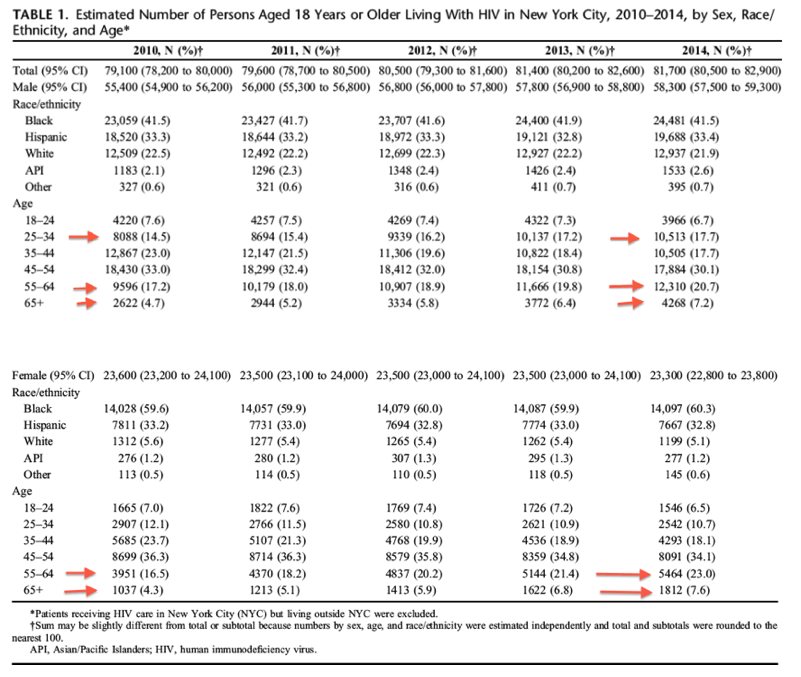
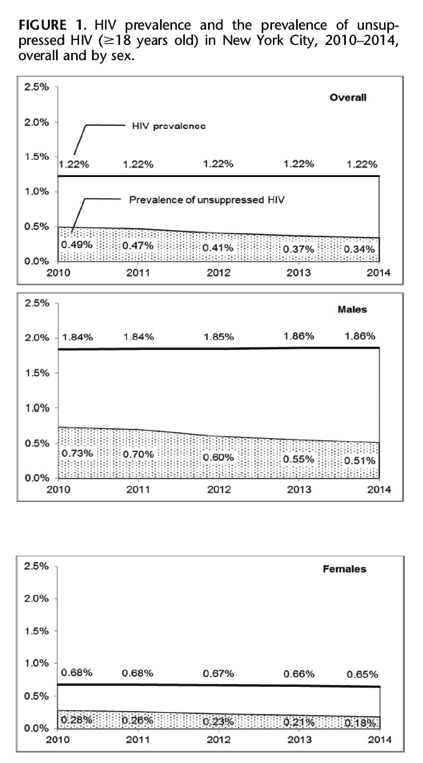
In the Supplemental Digital Content, eFigure 1, http://links.lww.com/QAI/A978 shows the same patterns in men that all races/ethnicities had stable HIV prevalence and decreasing prevalence of unsuppressed HIV. Black men had the highest HIV prevalence and prevalence of unsuppressed HIV. The black-white ratio of prevalence of unsuppressed HIV was larger (1.302%/0.226% = 5.8 in 2014) than the black-white HIV prevalence ratio (3.763%/1.170% = 3.2 in 2014). Hispanics had the second highest HIV prevalence and prevalence of unsuppressed HIV. The Hispanic-white ratio of prevalence of unsuppressed HIV was also larger (0.607%/0.226% = 2.7 in 2014) than the Hispanic-white HIV prevalence ratio (2.257%/1.170% = 1.9 in 2014).
eFigure 1. HIV prevalence and the prevalence of unsuppressed HIV among males in New York City, 2010-2014, by race/ethnicity
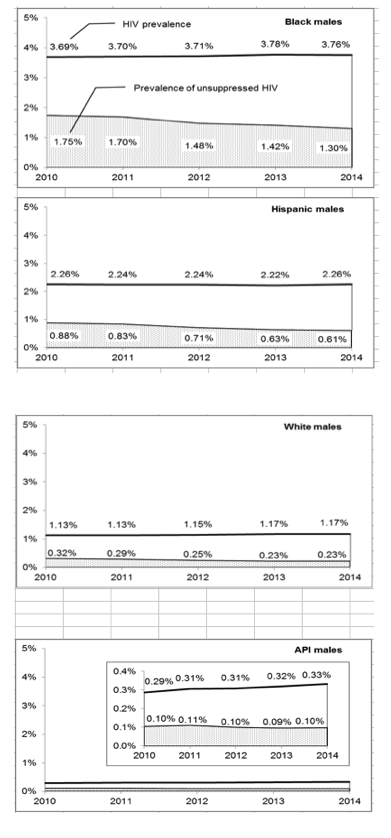
eFigure 2, http://links.lww.com/QAI/A978 shows the same patterns in women that all race/ethnicities had stable HIV prevalence and decreasing prevalence of unsuppressed HIV. Black women had the highest HIV prevalence and prevalence of unsuppressed HIV. The black-white ratio of prevalence of unsuppressed HIV was larger (0.524%/0.020% = 26.3 in 2014) than the black-white HIV prevalence ratio (1.678%/0.101% = 16.7 in 2014). Hispanics had the second highest HIV prevalence and prevalence of unsuppressed HIV. The Hispanic-white ratio of prevalence of unsuppressed HIV was also larger (0.199%/0.020% = 10.0 in 2014) than the Hispanic-white HIV prevalence ratio (0.801%/0.101% = 8.0 in 2014).
eFigure 2. HIV prevalence and the prevalence of unsuppressed HIV among females in New York City, 2010-2014, by race/ethnicity
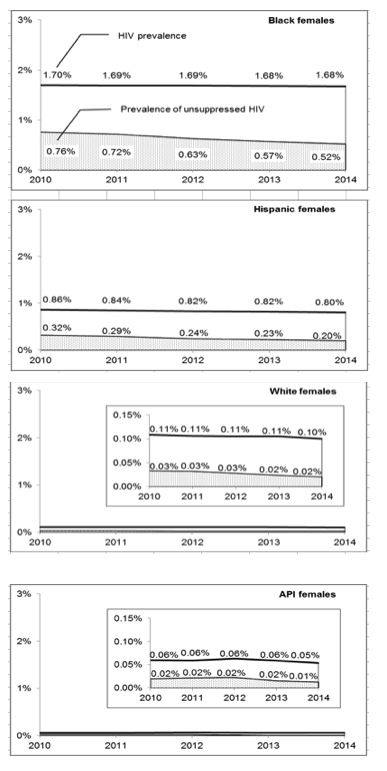
eFigure 3, http://links.lww.com/QAI/A978 shows a different pattern by age from the overall one in that male HIV prevalence increased among persons aged 25-34, 55-64, and 65+ year-olds, was stable among 18-24-year-olds, and decreased among 35-44 and 45-54-year-olds. The prevalence of unsuppressed HIV increased among 65+ year-olds and decreased in all other age groups. The 45-54-year-old group had the highest HIV prevalence (3.35% in 2014) and highest prevalence of unsuppressed HIV (0.73% in 2014).
eFigure 3. HIV prevalence and the prevalence of unsuppressed HIV among males in New York City, 2010-2014, by age
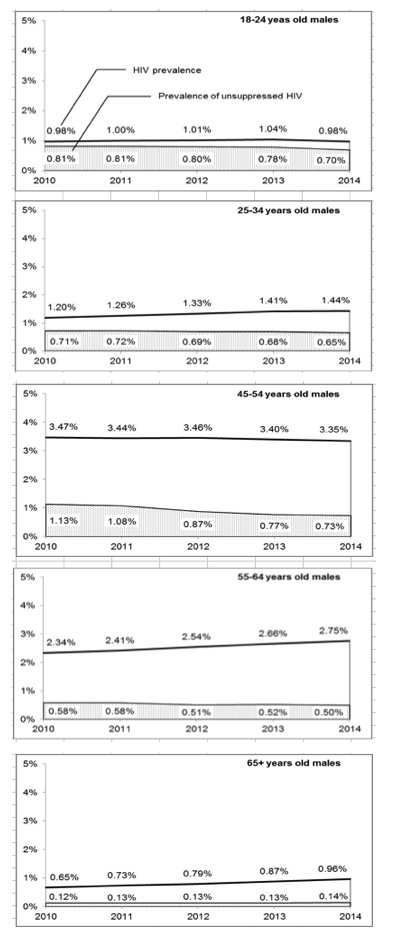
eFigure 4, http://links.lww.com/QAI/A978 differs from the overall pattern in that women HIV prevalence increased among 55-64 and 65+ year-olds, was stable among 18-24-year-olds, and decreased among 25-34, 35-44, and 45-54-year-olds. The prevalence of unsuppressed HIV was stable among 65+ year-olds and decreased in all other age groups. As with men, 45-54-year-olds had the highest HIV prevalence (1.39% in 2014) and highest prevalence of unsuppressed HIV (0.33% in 2014).
eFigure 4. HIV prevalence and the prevalence of unsuppressed HIV among females in New York City, 2010-2014, by age
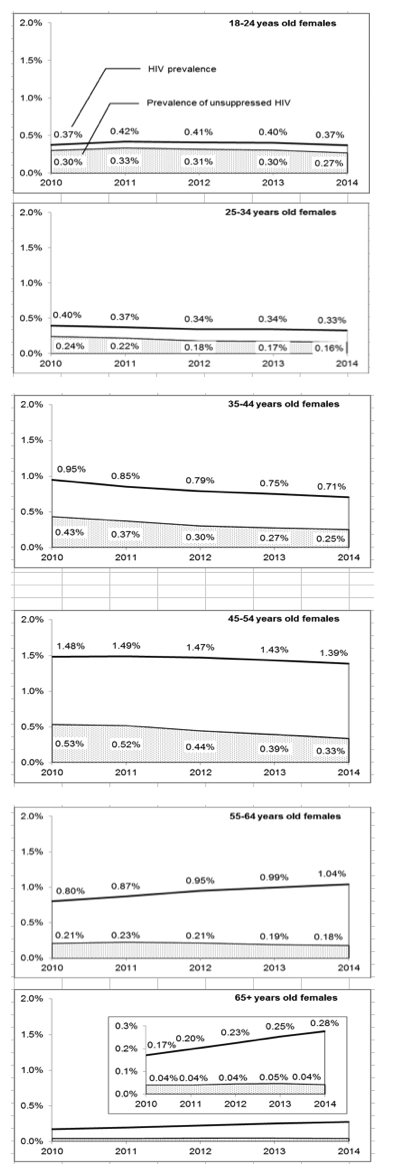
DISCUSSION
We have reported HIV prevalence and the prevalence of unsuppressed HIV in NYC, 2010-2014. HIV prevalence was used to describe the disease burden. The stable prevalence (1.22%) in NYC reflects the fact that the increase in the number of PLWH (numerator) was offset by the increase in the population (denominator). The prevalence of unsuppressed HIV was used to describe population-level transmission risk. In NYC, this prevalence decreased from 0.49% in 2010 to 0.34% in 2014, indicating that population-level transmission risk in NYC was decreasing. The large decrease between 2011 and 2012 occurred after the recommendation by the New York City Commissioner of Health that ART be started for all PLWH regardless of their CD4 cell count.15
Comparing differences across racial/ethnic groups, the 2 measures also give us a new perspective on racial disparities. For example, among women the black-white ratio of HIV prevalence was 17 and that of unsuppressed HIV was 26. The differences in these 2 ratios demonstrate that people of color have higher HIV disease burden (HIV prevalence) and even higher population-level HIV transmission risk (prevalence of unsuppressed HIV).16
Comparing differences across age groups, we observed that the prevalence of unsuppressed HIV was decreasing in all age groups, and HIV prevalence was stable or decreasing in younger age groups but increasing in older age groups, suggesting that PLWH with unsuppressed viral load were living a longer life.17
The measure, prevalence of unsuppressed HIV, has limitations. First, the measure does not quantify the exact population-level transmission risk. For example, if the prevalence of unsuppressed HIV in a community decreased from 1.0% to 0.5%, we could say that the prevalence of unsuppressed HIV decreased by 50% and population-level transmission risk was reduced, but we could not say that population-level transmission risk was reduced by 50% because population-level transmission risk depends on many factors in addition to the prevalence of unsuppressed HIV, such as sexual network structure and dynamics, sexual practices, and practices and networks of persons who inject drugs.18-21 This limitation also applies to the measure of viral load as an individual's transmission risk because individual transmission risk also depends on many factors beyond viral load as noted.22,23 Nevertheless, it does not prevent us from using viral load as a measure of an individual's transmission risk,24-26 nor should it prevent us from using the prevalence of unsuppressed HIV as a measure of population-level transmission risk.
Second, a more accurate measure of population-level transmission risk would be the ratio of the number of persons able to transmit HIV (PLWH with an unsuppressed viral load) to the number of persons who are at risk of infection (HIV-negative individuals). When HIV prevalence is low, the prevalence of unsuppressed HIV is a good approximation of the ratio, but when HIV prevalence is high, the prevalence is no longer a good approximation. For example, when HIV prevalence is 5%, the ratio would be 5.3% (5%/95% = 5.3%); when HIV prevalence is 20%, the ratio would be 25% (20%/80% = 25%). Although HIV prevalence is high in some communities, it is not so high that it makes the prevalence of unsuppressed HIV very different from the ratio. In addition, when we make comparisons, we usually compare 2 communities with similar HIV prevalence. Thus, the difference between the prevalence of unsuppressed HIV and the ratio would have little impact. Finally, the prevalence of unsuppressed HIV has 2 advantages over the ratio: (1) it can be presented with HIV prevalence in the same figure, and (2) it can be used with HIV prevalence to compute another measure, the proportion of PLWH with viral suppression. Therefore, we propose using the prevalence of unsuppressed HIV, instead of the ratio, to measure population-level transmission risk.
Third, an individual's viral load is dichotomized into 2 categories, suppressed and unsuppressed, for this estimate. This means that all persons with an unsuppressed viral load are given the same weight, although it is known that transmission risk is directly proportional to viral load.24,26 Some studies suggest that HIV transmission is unlikely to occur when viral load is less than 1500 copies/mL.24,25 The threshold of 200 copies/mL to define unsuppressed viral load for the measure of population-level transmission risk may seem to be too low. The reason for dichotomizing viral load is that there is no consensus on the weights for any given viral load value or interval. Although studies show that each 10-fold increase in viral load increases the risk of HIV transmission by approximately 3-fold,24,26 there is no reason to believe that 1 person with a viral load of 100,000 copies/mL is as "risky" as 3 persons with a viral load of 10,000 copies/mL and should therefore receive 3 times the weight.18 Besides the simplicity of dichotomizing viral loads, another advantage of this measure is that it calculates the potential workload for public health intervention, ie, number of persons who need ART and/or adherence support to control their viral loads. A 1% prevalence of unsuppressed HIV means that 1 in 100 people in the community needs ART and/or adherence support. We choose 200 copies/mL as the threshold because it is used by CDC to monitor the progress toward achieving viral suppression goals in the National HIV/AIDS Strategy.
In conclusion, the prevalence of unsuppressed HIV is a useful measure of population-level transmission risk. In our analysis, we used surveillance data to describe the prevalence of unsuppressed HIV by sex, race/ethnicity, and age. The prevalence of unsuppressed HIV among risk populations can be estimated using data from cross-sectional surveys.27,28 As ART continues to expand in the United States and across the world, programs should consider using the prevalence of unsuppressed HIV to measure population-level transmission risk.15,29
|
|
| |
| |
|
|
|